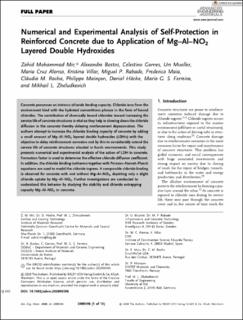| dc.contributor.author | Mir, Zahid Mohammad | |
| dc.contributor.author | Bastos, Alexandre | |
| dc.contributor.author | Gomes, Celestino | |
| dc.contributor.author | Mueller, Urs | |
| dc.contributor.author | Alonso, Maria Cruz | |
| dc.contributor.author | Villar, Kristina | |
| dc.contributor.author | Rabade, Miguel P. | |
| dc.contributor.author | Maia, Frederico | |
| dc.contributor.author | Rocha, Cláudia M. | |
| dc.contributor.author | Maincon, Philippe Emmanuel | |
| dc.contributor.author | Höche, Daniel | |
| dc.contributor.author | Ferreira, Mario G. S. | |
| dc.contributor.author | Zheludkevich, Mikhail L. | |
| dc.date.accessioned | 2021-08-26T11:11:19Z | |
| dc.date.available | 2021-08-26T11:11:19Z | |
| dc.date.created | 2021-02-15T14:47:31Z | |
| dc.date.issued | 2020 | |
| dc.identifier.citation | Advanced Engineering Materials. 2020, 22 (11), 1-13. | en_US |
| dc.identifier.issn | 1438-1656 | |
| dc.identifier.uri | https://hdl.handle.net/11250/2771386 | |
| dc.description.abstract | Concrete possesses an intrinsic chloride binding capacity. Chloride ions from the environment bind with the hydrated cementitious phases in the form of bound chlorides. The contribution of chemically bound chlorides toward increasing the service life of concrete structures is vital as they help in slowing down the chloride diffusion in the concrete thereby delaying reinforcement depassivation. The authors attempt to increase the chloride binding capacity of concrete by adding a small amount of Mg–Al–NO2 layered double hydroxides (LDHs) with the objective to delay reinforcement corrosion and by this to considerably extend the service life of concrete structures situated in harsh environments. This study presents numerical and experimental analysis of the action of LDH in concrete. Formation factor is used to determine the effective chloride diffusion coefficient. In addition, the chloride binding isotherms together with Poisson–Nernst–Planck equations are used to model the chloride ingress. A comparable chloride binding is observed for concrete with and without Mg–Al–NO2, depicting only a slight chloride uptake by Mg–Al–NO2. Further investigations are conducted to understand this behavior by studying the stability and chloride entrapping capacity Mg–Al–NO2 in concrete. | en_US |
| dc.language.iso | eng | en_US |
| dc.publisher | Wiley | en_US |
| dc.rights | Navngivelse 4.0 Internasjonal | * |
| dc.rights.uri | http://creativecommons.org/licenses/by/4.0/deed.no | * |
| dc.title | Numerical and Experimental Analysis of Self‐Protection in Reinforced Concrete due to Application of Mg–Al–NO2 Layered Double Hydroxides | en_US |
| dc.type | Peer reviewed | en_US |
| dc.type | Journal article | en_US |
| dc.description.version | publishedVersion | en_US |
| dc.rights.holder | © 2020 The Authors. Published by WILEY-VCH Verlag GmbH & Co. KGaA,Weinheim. This is an open access article under the terms of the CreativeCommons Attribution License, which permits use, distribution andreproduction in any medium, provided the original work is properly cited. | en_US |
| dc.source.pagenumber | 1-13 | en_US |
| dc.source.volume | 22 | en_US |
| dc.source.journal | Advanced Engineering Materials | en_US |
| dc.source.issue | 11 | en_US |
| dc.identifier.doi | 10.1002/adem.202000398 | |
| dc.identifier.cristin | 1889984 | |
| dc.relation.project | EC/H2020/685445 | en_US |
| cristin.ispublished | true | |
| cristin.fulltext | original | |
| cristin.qualitycode | 1 | |

